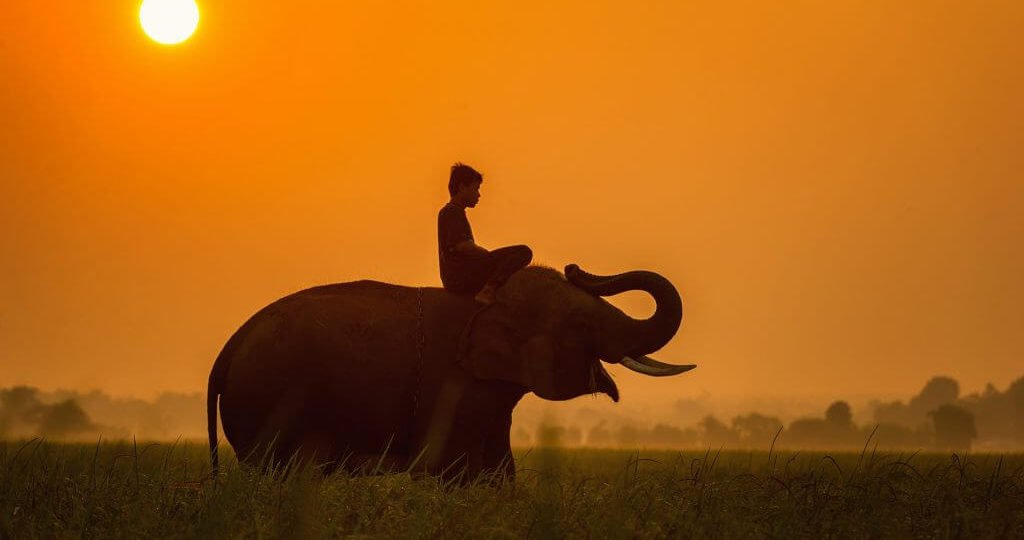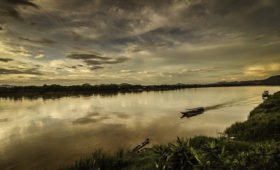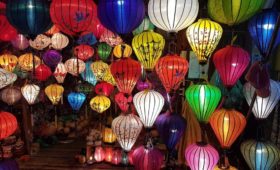BAKTRAX IN CAMBODIA:
Small Group Tours of Cambodia
SEE AWE INSPIRING ANGKOR WAT, HORRORS OF THE KILLING FIELDS and S21 then CHILL AT SIHANOUKVILLE
Cambodia has had a pretty bad run of luck for the last half-millennium or so. Ever since the fall of Angkor in 1431, the once mighty Khmer Empire has been plundered by all its neighbours. It was colonized by the French in the 19th century, and during the 1970s suffered heavy carpet bombing by the USA. After a false dawn of independence in 1953, Cambodia promptly plunged back into the horrors of civil war in 1970 to suffer the Khmer Rouge’s incredibly brutal reign of terror, and only after UN-sponsored elections in 1993 did the country begin to totter back onto its feet.
Much of the rural population still subsists on less than the equivalent of US$1 a day, the provision of even basic services remains spotty, especially in rural areas, and political intrigue remains as complex and opaque as ever; but the security situation has improved immeasurably, and increasing numbers of visitors are rediscovering Cambodia’s temples and beaches. Siem Reap, the gateway to Angkor, now sports a wide range of hotels, chic nightspots, ATMs, and an airport fielding flights from all over the region, while Sihanoukville is getting good press as an up-and-coming beach destination. However travel beyond the most popular tourist destinations can still be a bit adventurous. Thankfully transport options and roads to the main attractions have improved rapidly over the last decade from the moonscape type roads on third world buses to paved roads on a variety of vehicles old and new. Tourism does have its benefits after all.
Baktrax Tours to Cambodia
Visit Angkor Wat, Siem Reap, Phnom Penh and Sihanoukville for less on a small group tour with Baktrax.
——————————————————————————–
Centuries in Cambodia Tour
This Cambodia small group tour of gives you the chance to see the real Cambodia and as the roads of the Khmer nation have been greatly improved recently this trip is no longer the arduous adventure it once was…
Continue reading →
——————————————————————————–
Laos Cambodia Combination Tour
The very best of both Laos and Cambodia on one tour, taking in Luang Prabang, Siem Reap, Angkor Wat and… Continue reading →
History
It is important to remember that Cambodian history did not begin with the Khmer Rouge. Pol Pot’s incredibly harsh regime has garnered most attention, but the Cambodians have enjoyed a long and often triumphant history. Anybody who witnesses the magnificent temples at Angkor can attest to the fact that the Khmer Empire was once wealthy, militarized, and a major force in the region. Its zenith came under Jayavarman VII (1181-ca. 1218), where the Empire made significant territorial gains from the Vietnamese and Cham. The Khmer Empire stretched to encompass parts of modern day Thailand, Malaysia, Burma, Laos, and Vietnam.
The period following the fall of the Khmer Empire has been described as Cambodia’s dark ages. Climatic factors precipitated this fall, where the Ankorian civilization harnessed Cambodia’s water for agriculture through elaborate systems of canals and dams. The Khmer Empire never recovered from the sacking by its neighbours, based in Ayutthaya (in modern day Thailand), and Cambodia spent much of the next 400 years until French colonization squeezed and threatened by the rivalries of the expanding Siamese and Vietnamese Empires to the West and East. Indeed, on the eve of French colonization it was claimed that Cambodia was likely set to cease to exist as an independent kingdom entirely, with the historian John Tully claiming “there can be little doubt that their [the French] intervention prevented the political disappearance of the kingdom”.
The French came to dominate Cambodia as a protectorate from the 1860s, part of a wider ambition to control the area then termed Indochina (modern day Cambodia, Vietnam and Laos). The French were always more concerned with their possessions in Vietnam. Education of Cambodians was neglected for all but the established elite. It was from this elite that many “Red Khmers” would emerge. Japan’s hold on Southeast Asia during the Second world War undermined French prestige and following the Allied victory Prince Sihanouk soon declared independence. This was a relatively peaceful transition; France was too absorbed with its struggle in Vietnam, which it saw as more important to its conception of L’Indochine Francaise.
Prince Sihanouk was the main power figure in the country after this. He was noted for making very strange movies in which he starred, wrote and directed. His rule was characterized at this point with a Buddhist revival and an emphasis on education. This was a mixed blessing, however. He succeeded in helping create an educated elite who became increasingly disenchanted with the lack of jobs available. As the economic situation in Cambodia deteriorated, many of these young people were attracted to the Indochinese Communist Party, and later the Khmer Rouge.
As the Second Indochina War spread to Cambodia’s border (an important part of the “Ho Chi Minh trail”), the USA became increasingly concerned with events in the country. The US Air Force bombed Cambodia from 1964 to 1973, with the period from March 1969 to May 1970 being particularly intense. During this campaign, which was codenamed Operation Menu, 540,000 tonnes of bombs were dropped. Estimates of the civilian death toll range from 150,000 to 500,000. In total, from 1964 to 1973 the US dropped 2.7 million tonnes of bombs on Cambodia: more than the combined amount dropped by all the Alllies in all theatres during World War II.
In March 1970, whilist overseas to visit Moscow and Beijing, Sihanouk was overthrown by Lon Nol and other generals who were looked upon favorably by the United States. Sihanouk then put his support behind the Khmer Rouge. This change influenced many to follow suit; he was after all considered a Boddhisatva. Meanwhile the Khmer Rouge followed the Vietnamese example and began to engender themselves to the rural poor.
Following a five-year struggle, Communist Khmer Rouge forces captured Phnom Penh in 1975 and ordered the evacuation of all cities and towns. Over 1 million people (and possibly many more) died from execution or enforced hardships. Those from the cities were known as “new” people and suffered worst at first. The rural peasantry were regarded as “base” people and fared better. However, the Khmer Rouge’s cruelty was enacted on both groups. It also depended much upon where you were from. For example, people in the East generally got it worse. It is debated whether or not the Khmer Rouge began “crimes against humanity” or a protracted “genocide”. There are claims there was a disproportionate number of ethnic Chams killed, and the ethnically Vietnamese also suffered persecution. Nonetheless, the Khmer also suffered often indescriminate mass killings.
A 1978 Vietnamese invasion drove the Khmer Rouge into the countryside and ended 13 years of fighting (but the fighting would continue for some time in border areas). Cold War politics meant that despite the horrendous crimes committed by the Khmer Rouge they were the recognized government long after the liberation of the country by the Vietnamese, indeed they continued to receive covert support and financing by the USA. As a result of the devastating politics of the Khmer Rouge regime, there was virtually no infrastructure left. Institutions of higher education, money, and all forms of commerce industries were destroyed in 1978, so the country had to be built up from scratch. UN-sponsored elections in 1993 helped restore some semblance of normalcy, as did the rapid diminution of the Khmer Rouge in the mid-1990s. A coalition government, formed after national elections in 1998, brought renewed political stability and the surrender of remaining Khmer Rouge forces.
TOURIST HIGH LIGHTS: Some of these should sadly be referred to as low lights simply because they revolve around the brutal history of Pol Phot and the Khmer Rouge.
SIEM REAP & ANGKOR WAT: We will start with one of not only Cambodia’s high lights but something equal to any high light anywhere on the planet. We refer of course to the Angkor Wat complex. This is a must see for anybody who considers themselves to be a world traveller but even if you are a once only overseas traveller this is about as good as it gets. The area is so large it would take weeks to see it all in detail. Luckily the major temples are close enough to see in a few hours with your Baktrax local guide. This leaves enough time for those wanting to explore even further afield.
The main temples being Angkor Wat itself, Angkor Thom, Bayon and Ta Prohm. With the latter a must see because of the huge tree roots having become entwined over the years with the ruins. Further afield the smaller but no less intricate temples of Banteay Samre and Banteay Srei are well worth a visit for those who don’t temple out and for really serious explorers a tough walk up a steep hill will get you to the river Linga’s which are carved into the rocks of a river bed. ( best visited in dry season). Far to many other temples to mention here but put simply, just a totally awesome complex of high lights.
SHOPPING:
After a hot day of exploration you will most likely feel like Pub street but for shoppers there are plenty of opportunities for that also.
If you havn’t got enough souvenirs and T shirts from the countless vendors who will follow you around the ruins then the numerous shops in town aimed at tourists will fill your bags for you. The Angkor Wat market has stalls selling handicrafts and numerous other sovenirs and is well worth a wander around also.
Just meander around and you will find plenty of fascinating things to see.
PHNOM PENH: Now its time for the low lights of Cambodia. These are must sees also. The infamous killing fields with the memorial stupa full of Skeleton heads are the first place you will be shown. After that you will visit Tuol Sleng prison known in the 70’s as S21. Has there ever been a mort inhumane place on Eearth? Here you will see how the pure evil of Pol Phot and his Khmer Rouge cadres went about creating their idea of utopia. Hire your own personel guide and you will hear some of their own true life stories but just wandering around on your own will be enough to see and feel the evil of the place. How could this happen to these wonderful people you are meeting today?
SHOPPING:
After all this depressing stuff the afternoon can be spent meeting some the lovliest people on earth while exploring one of the many large markets of the capital. Lots more clothing, handicrafts and souvenirs to be had at very cheap prices for those who can barter the best. There is a skill to it so learn fast and save money. The first and best tip is to always keep smiling
.
The central market is within walking distance and easily found with the strange looking art deco building standing out like a beacon. Take a short moto ride to get to Psar Tuol Tom Pong or more commonly known as the Russian market for even more great bargains or Psar O Russei for more upmarket food and imported products.
After all this activity the Corner Bar or one of the many other great bars or restaurants along Sisowath Quay will be the order of the day.
FOOD: While Cambodian food may be no where near as famous as its neighbours you will still get a good feed whether it be international or local.
The capital and even more so in Seam Reap there are numerous international food restauants from French to Mexican or Thai with the local food a must try also.
Fish is one of the main staples with all the water around and cooked in a banana leaf with various herbs and spices it will be hard to go past. Like its neigbours also, the popular Asian bowl of noodle soup in its various forms is a full meal in itself and can be had roadside or in a local market for a dollar or less.
Lemongrass, coriander and mint are but only three of the many herbs and spices used with fermented fish paste to lift flavour levels also.
One particular Khmer delight which came about as a result of the food shortages during the Khmer Rouge era is fried Spiders. It seems they were such a hit that they are still enjoyed today in a few places. Pizza or chips may be a better choice for a full meal though. Passing through local non tourist places with Baktrax will always turn up something new and surprising to first time visitors.
DRINKS: Beeer is regularly enjoyed by the population as much as anywhere else. So that wont be a problem to find. Angkor beer is the local brew and it’s as good a drop as can be found anywhere. Bars and pubs are all over the tourist areas with a draft beer costing a dollar or less. More expensive international beers will usually be available also but why would you bother. One drinking hole worth a mention for its atmosphere in the capital is The Garden Bar “in the shade”. Not many better places for a pre dinner drink than sitting in a colonial style wicker chair overlooking the Tonle Sap river. Your shout at 5.00.
Pub street in Seam Reap lives up to its name also after a hard day of temple exploration
While regular wine is readily available when locals talk about wine it usually means fermented rice wine as powerful as rocket fuel. Non experienced drinkers stay completely away.
Regular spirits available also.
SOFT DRINKS: All the regulars will be found along with one particular local fav of fruit shakes. Similar to smoothies these are made with fresh fruit and hold the egg if you dont want it too frothy. Delicious!
We havn’t much mentioned the best of all in Cambodia as yet though. That being the people themselves. When you see all that has happened and the terrible poverty that is still apparent in places it will be hard to understand how they can still be as happy, nice and hospitable as they are. You may encounter people with missing limbs due to past as well as the many still active land mines still laying in wait for some poor unsuspecting farmer. A more stoic people than the Khmer would be hard to find. Many speak english also so no communication problems for the most part. Again, simply put the word Charming first comes to mind of the population.




